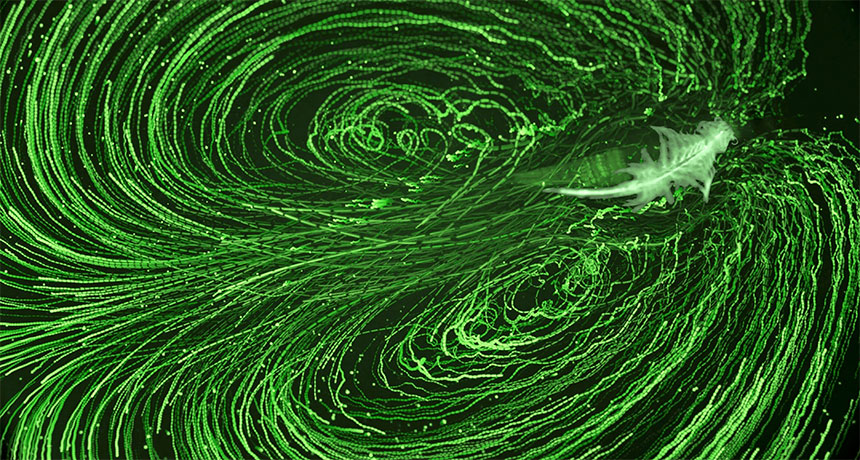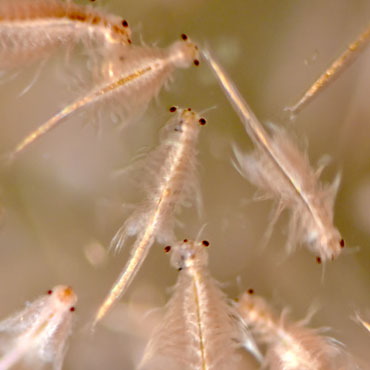Small swimmers may play huge role in churning the seas
Masses of shrimp and krill stir up currents that could loft nutrients up from the deep

A single swimming brine shrimp moves the water near its body. The green lines trace the movement over time of particles in the water as the shrimp swims. Large numbers of the animals moving together could create currents strong enough to stir oceans.
Isabel Houghton
Animals swim by pushing on the water around their bodies. Even small ocean swimmers such as krill — tiny shrimplike animals — make mini currents with each kick. And if there are lots of these tiny creatures? Together they may be powerful enough to stir up water hundreds of meters (yards) deep, a new study suggests.
That water mixing is important because many nutrients are unevenly spread throughout the ocean. Near the surface, microscopic marine plants and bacteria use sunlight to make food. In the process, they use up mineral nutrients in the water. These include nitrogen and phosphorus. So shallow water gets sapped of these nutrients. But deeper water contains lots of such nutrients. Stirring up the ocean helps carry the nutrient-rich deep water up toward the surface where plants can use it.
Wind, tides and large currents all help mix the ocean. But swimming animals move water, too. And researchers wanted to know whether small but very abundant critters might play a role. They were thinking about centimeter (half-inch) sized krill and even tinier crustaceans known as copepods (KOH-puh-podz).
John Dabiri works at Stanford University in California. He studies how fluids move around objects, including animals. Early on, he says, scientists didn’t think creatures as small as krill could have much effect on a big ocean. “The original thinking is that these animals would flap their appendages and create little eddies about the same size as their bodies,” he says.
But then, measurements of krill migrating in the ocean suggested that they might stir up more turbulence than researchers had at first thought possible. So did computer programs used to predict the flow of water around swimming jellyfish and copepods.
In 2014, Dabiri coauthored a study to measure how water moved around swimming brine shrimp in a lab. Brine shrimp are small crustaceans that look similar to krill. Brine shrimp in tanks created jets and eddies in the water much larger than themselves, that study showed. “But there was skepticism about whether those lab results were relevant to the ocean,” Dabiri says.
Why? Ocean water is not uniform. Some spots are warmer, others cooler. Some parts have more salt than others. Such differences can divide the water into layers, each having its own temperature or salt concentration. Such layers don’t easily mix. And the 2014 study hadn’t accounted for such layers. So it wasn’t clear if krill- or brine-shrimp-generated turbulence would be strong enough or travel deeply enough to really mix up a layered ocean.
Shrimp power
In the new study, Dabiri’s team asked whether tiny animals had the swimming power to mix ocean layers. To test this, they used two tanks of water in their lab. One was 1.2 meters (4 feet) deep, the other 2 meters (about 6 feet) deep. Each tank contained two layers of water. One layer contained more salt, which made it sink to the bottom. Each tank also held tens of thousands of wiggly brine shrimp. They look like a pink cloud shifting in the water.

Bright lights attract brine shrimp, so the researchers used LED lights to prompt the shrimp to migrate up or down within the tanks. These movements mimicked the massive daily vertical migrations that ocean krill, copepods and other small swimmers make to feed and rest.
The shrimp migrated in a tight bunch. And being so close together helped to magnify their individual efforts.
“As one animal swims upward, it’s kicking backward,” Dabiri says. That same bit of water then gets kicked downward by another nearby animal. Then another, and another. The result is a downward rush that gets stronger as the migration continues. Eventually it extends downward about as deep as the entire group of moving animals. In the ocean, that could be as much as hundreds of meters.
The swimming shrimp moved the water at a speed of about 1 to 2 centimeters (0.5 to 1 inch) per second. The resulting jet was powerful enough to mix the shallow water in each tank with the deeper, saltier water. The researchers reported their findings online April 18 in Nature.
What’s the big deal?
Ocean mixing is an important part of the global climate cycle, Dewar points out. It churns up nutrients that feed will feed blooms of algae at the surface. That mixing also affects how gases, such as carbon dioxide, move between the water and the air above.
Scientists already knew that mixing occurred. But if tiny animals were behind part of that mixing, it might change how scientists studied things moved by ocean currents, he says.
And that question — can tiny animals do any important mixing — was at the heart of the new study, notes William Dewar. He was not part of the study. But as an oceanographer at Florida State University in Tallahassee, he understands the issues here. The new findings “argue quite compellingly” that tiny animals can kick up a good bit of mixing, he says. Those findings, he concludes, “strongly counter the concern that most marine life is simply too small in size to matter.”
The next step will be to try to measure similar effects at sea from ships, Dabiri says. “Previous studies looked for turbulence or eddies on the scale of the animals’ size,” he says. They didn’t look for large downward jets of water. “This paper tells us for the first time what to look for.”







